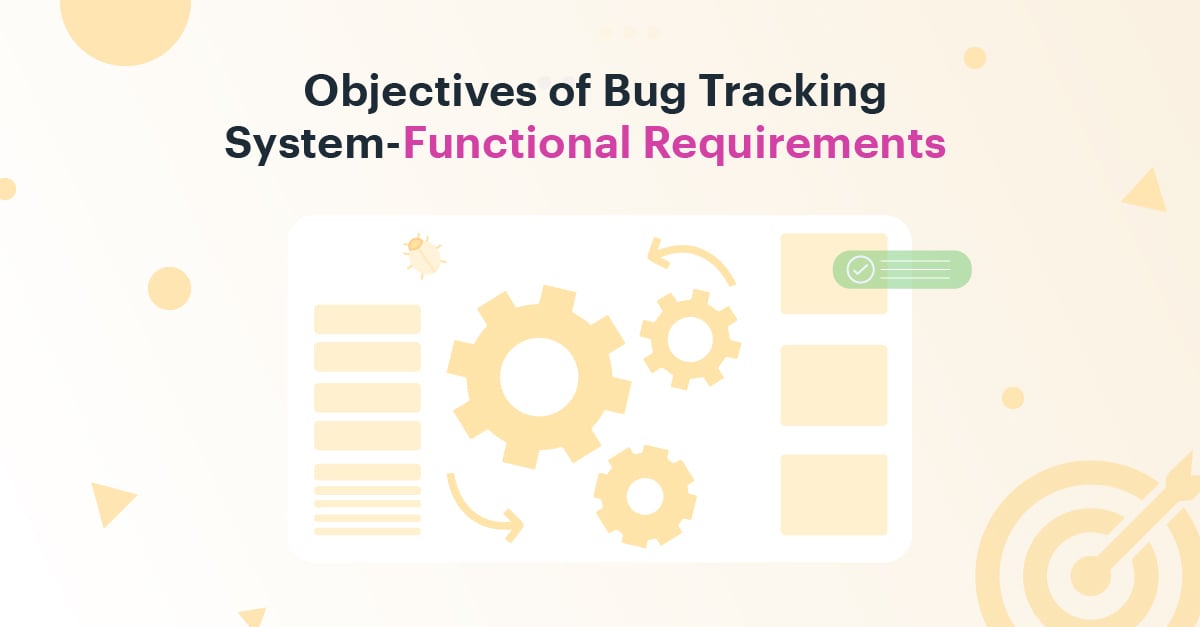What is a Bug?
A bug refers to any defect in the design, coding, and features of a product that can cause it to malfunction or deliver incorrect results in a product. The process of identifying these defects in a product is known as bug tracking. This is a vital process that must be executed appropriately if you want to deliver quality products to end-users.
A bug tracking software is an essential tool for managing the process of finding, tracking, and fixing bugs. Not only does it ensure that you deliver a high-quality near-perfect product, but it also enhances the productivity of the development team throughout the product development process.
A Synopsis of the Bug Tracking Process
Detection
Bugs can either be detected by the developer or the product testing team during the testing phase of the product development lifecycle or can be reported by end-users
Fixing
When bugs are identified, vital information about the bug is collected. Once this is done, developers assess the impact of the bug and start looking for the best approach to fix the bug quickly and efficiently. Bugs are then fixed based on their level of criticality.
Testing
After fixing the bug, the product is tested multiple times to ensure that everything checks out and the product works properly. Sometimes fixing one bug gives rise to others. And these have to be fixed before deployment.
Reviewing and reporting
The bug tracking process generates a lot of data that can be valuable to the product development process. Details of the bug tracking process are reviewed then recorded for future reference.
Scope of Bug Tracking System & Functional Requirements
The basic objective of a good bug tracking software allows teams to identify defects easily, measure their scope, determine their impact, and manage all the steps involved in resolving them, all from a centralized interface.

Identify Bugs Early
Ideally, defects in a product should be identified as early as possible. In the early stages, bugs are easier and less costly to fix. A good number of bug tracking software allow end-users to easily report bugs directly to the developer and include all the details needed to identify and track them.
Track Bugs Through Their Life Cycles
The first step in fixing bugs is to identify and prioritize them. The development team has to decide whether a bug is a system critical (causes the system to crash or affects a core feature) or minor. Then bugs have to be prioritized in order of their severity, and a response timeline for each is set. By using a good bug tracking tool, teams get a single workflow from where its entire life cycle can be managed. This also ensures easy traceability and simplifies bug reporting.
Reduce the Cost of Development
One of the primary objectives of the bug tracking tool is to reduce the cost of the development. In addition to aiding the development of quality products (which boost product competitiveness), effective bug tracking also helps to reduce the overall cost of the development process. A good bug tracking software has tools for quicker bug resolution, which allows the development team to avoid product release delays. A result is a reduction in production cost and a higher return on investment for the product company. Furthermore, bug tracking software provides a robust knowledge base that can be used for future reference to prevent a recurrence in the future.
Flexible Fix and Deployment Workflows
Rather than managing the bug fixing process using spreadsheets, emails, and other fragmented resources, bug tracking software puts all your bugs and the resources needed to resolve them in the same place. This makes it possible to create custom workflows that automate the process of tracking and monitoring these bugs and any other issues that may arise from them.
Collaboration
Another important purpose of a bug tracking system is to enable team collaboration and communication. Typically, it is an integral part of a case management software with features such as in-app chat and notifications that helps to keep everyone working on testing, identifying bugs, and fixing them in the same place. You can prioritize tasks and assign them accordingly to different members of your development team. The ease of access to real-time information and updates about the status of a bug fix also allows better collaboration and accountability.
Better Product Experience, Happier Customers
A bug tracking software keeps all issues relating to your bugs in the same place and ensures that they are fixed appropriately. Not only does It provide visibility to all the aspects of the project, but it also has tools for in-depth analysis and control. Having a single platform from where everything is tracked is particularly valuable for companies running large projects. A bug tracking tool provides a platform from which all of these multiple moving parts involved in resolving bugs are seamlessly managed is critical to delivering a bug-free product that will leave customers satisfied.
Identify trends
When resolving bugs, it is crucial to resolve issues in the now and prevent a recurrence. Using a tool that helps identify bug trends and analyze them deeply will be valuable for your future development efforts. In addition to avoiding recurring issues, identifying trends also makes it easier to resolve them if they do occur.
Conclusion
Bug tracking tool is an unavoidable part of product development. To ensure that this all-important stage yields the best results, innovative companies are turning to bug tracking software for their bug tracking process.
A robust tool like Kissflow Workflow aids the delivery of high-quality finished products to users at a reduced development cost. It effectively serves most of the purpose of a bug tracking system tool. Kissflow’s customizable bug tracking solution helps developers and testers enhance team productivity, resolve bugs without disruption, and deliver high-quality products quickly and efficiently.
Is your bug tracking tool serves its purpose? Want to learn how to turbocharge your bug tracking process? Signup today for free.









